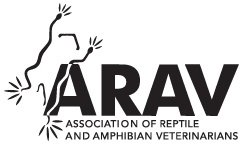Systemic Nannizziopsis arthrosporioides in an African Side-neck Turtle (Pelomedusa subrufa)
A 2-yr-old female African side-neck turtle (Pelomedusa subrufa) housed at a pet store in Illinois, USA presented for evaluation of nasal discharge and an ulcerative skin lesion. Molecular diagnostics for Mycoplasma spp., herpesviruses, and frog virus 3 (ranavirus) were negative, and cytologic evaluation of the ulceration showed nonseptic inflammation without fungal elements. A presumptive diagnosis of a bacterial upper respiratory infection was treated with ceftazidime (20 mg/kg SC every 72 h) and husbandry improvements were recommended. One month later, the turtle re-presented; physical examination revealed diffuse skin sloughing and severe dehydration, and the animal was euthanized. Necropsy and histopathology revealed multiple fungal granulomas throughout the liver, gastrointestinal tract, and lungs. Heavy growth of a white powdery fungal organism was obtained from culture. Four gene targets (D1/D2 domains of the 28S ribosomal DNA, 18S-28S ribosomal internal transcribed spacer region, actin, and β-tubulin) were sequenced from the fungal isolate and each was >98% identical to Nannizziopsis arthrosporioides. A maximum-likelihood phylogenetic tree constructed from concatenated D1/D2, ITS, actin, and β-tubulin sequences from Nannizziopsis spp. placed the new fungal isolate in a highly supported (99% bootstrap support) monophyletic group with two N. arthrosporioides isolates. This case report describes the first known N. arthrosporioides infection in an aquatic turtle species and adds to the growing literature surrounding N. arthrosporioides infections in nonsquamate reptilian patients.Abstract

Histopathologic confirmation of fungal granulomas in the pulmonary tissues of an African side-neck turtle (Pelomedusa subrufa). (A) Hematoxylin and eosin (H&E) stain (×10 magnification) revealing classic granuloma formation with multinucleated giant cells admixed with additional inflammatory cells and occasional septated fungal hyphae. (B) Grocott's methenamine silver (GMS) stain (×10 magnification) revealing hyphae and pseudohyphae (black stain uptake) with nonparallel walls, irregular branching, and irregular septation.

Maximum-likelihood phylogenetic trees depicting the relationship between a fungal isolate from an African side-neck turtle (Pelomedusa subrufa) and other Nannizziopsis spp. Gene targets include (A) actin, (B), b-tubulin, (C) D1/D2 domains of the 28S ribosomal DNA, and (D) 18S-28S ribosomal internal transcribed spacer region including the 5.8S rDNA. Bootstrap values are displayed at the nodes. Scale bar indicates the number of substitutions per site. Ophidiomyces ophidiicola is included as an outgroup.

Maximum-likelihood phylogenetic tree depicting the relationship between a fungal isolate from an African side-neck turtle (Pelomedusa subrufa) and other Nannizziopsis spp. Concatenated gene targets include actin, b-tubulin, D1/D2 domains of the 28S ribosomal DNA, and 18S-28S ribosomal internal transcribed spacer region including the 5.8S rDNA. Bootstrap values are displayed at the nodes. Scale bar indicates the number of substitutions per site. Ophidiomyces ophidiicola is included as an outgroup.
Contributor Notes



